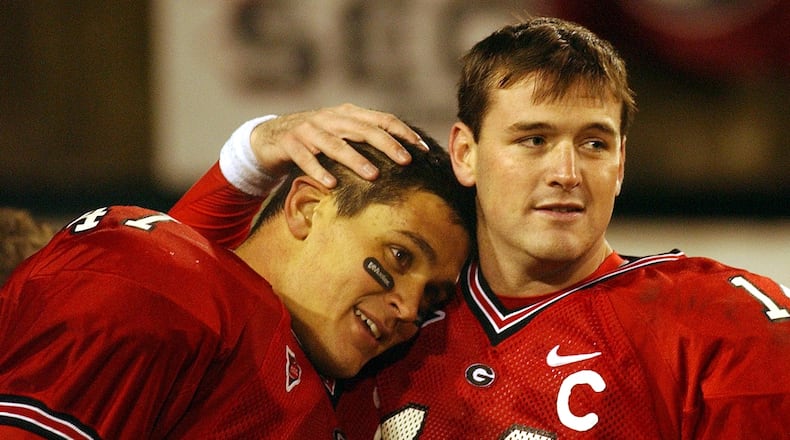A panel of AJC voters chose these players as the top 10 Georgia football players from 2000-09. The players are listed alphabetically.
Boss Bailey
Rodney “Boss” Bailey was bigger than his older brothers Champ and Ronald. Starring at outside linebacker for the Bulldogs, he led the 2002 SEC championship team in tackles with 114 while also recording six sacks and 9.5 tackles for loss. But Boss’s real specialty was blocking kicks. His 46-inch vertical leap helped him block three field-goal attempts in 2002. That would lead to an NCAA rules change – the “Boss Bailey rule” – which made it a 15-yard penalty to leap over the middle of line.
Credit: AP
Credit: AP
Thomas Davis
Davis was known as a ferocious hitter at free safety, where he led the Bulldogs in tackles in 2003 and ‘04 and earned All-American honors as a senior. A consensus All-SEC pick his final two seasons, Davis finished with 272 career tackles, 10.5 sacks, 17 tackles for loss and 27 pressures. Davis moved to linebacker in the NFL, where he played 15 seasons despite having to overcome three major knee injuries. He was named NFL Man of the Year in 2014.
Credit: University of Georgia
Credit: University of Georgia
Terrence Edwards
The younger brother of former UGA star Robert Edwards, Terrence made his living catching the ball downfield. Playing for the Bulldogs from 1999-2002, he remains the only receiver to accumulate more than 1,000 yards receiving in a single season (1,004 in 2002). He also is Georgia’s all-time leader in career receiving yards (3,093), receptions (204) and TD catches (30). Edwards played nine seasons in the CFL. After retiring, he founded TE WR Academy and now is head coach at Mount Vernon School in Sandy Springs.
Credit: AJC staff
Credit: AJC staff
A.J. Green
Green came to UGA from Summerville, South Carolina, as the top receiver prospect in the country. Green was indeed prolific, catching 166 passes for 2,619 yards and 26 touchdowns – all top five in UGA annals – in only three seasons. But he missed the first four games of the 2010 season because of a controversial NCAA ruling that would be moot by today’s NIL rules. Green was the fourth pick of the 2011 draft and played 12 NFL seasons with the Bengals and Cardinals.
Credit: Brant Sanderlin, bsanderlin@ajc.com
Credit: Brant Sanderlin, bsanderlin@ajc.com
David Greene
Greene is known as the quarterback who changed Georgia’s fortunes under coach Mark Richt in 2001. As a redshirt freshman starter that season, Greene threw the game-winning TD pass to Verron Haynes in the “Hobnail Boot” victory over Tennessee in Knoxville. The next year, left-hander led the Bulldogs to their first SEC championship in 20 years. He left Georgia in 2004 as the quarterback with the most wins in SEC history with 42-10 record over four seasons. His 11,528 career yards passing also were a conference record.
Credit: Brant Sanderlin/AJC file photo
Credit: Brant Sanderlin/AJC file photo
Max Jean-Gilles
No one was better at giving Georgia’s prolific offense time and space to operate than Jean-Gilles. One of the Bulldogs’ first South Florida recruiting victories, the 6-foot-4, 350-pound Jean-Gilles signed with Georgia out of North Miami Beach High. After learning the ropes as a freshman reserve, he broke into the starting lineup at right tackle as a sophomore and started every game at tackle or guard the next three seasons. He became a consensus All-American in Georgia’s 2005 SEC championship season, then played five NFL seasons.
Credit: Special
Credit: Special
Knowshon Moreno
Moreno came to Georgia from Belford, New Jersey, and reignited the Bulldogs’ reputation as Tailback U. The Bulldogs would get only two seasons with Moreno as he redshirted in 2006 while biding his time behind established juniors Thomas Brown and Kregg Lumpkin. Finally unleashed in 2007, Moreno was burst on the scene with 1,587 yards and 14 touchdowns his first season and 1,792 and 18 as a sophomore. Drafted by the Broncos with the 12th pick, injuries limited Moreno’s NFL career to five seasons.
Credit: Bob Andres
Credit: Bob Andres
David Pollack
Pollack and Herschel Walker remain the Bulldogs’ only three-time, first-team All-Americans. Signing with UGA as a fullback, Pollack was moved to defensive line as a freshman, starting five games at tackle. Pollack switched the next year to end, where over the next three seasons he would set the UGA record with 36 sacks. Awards that came his way included the Hendricks (2003), Lombardi (2004), Bednarik (’04) and Lott (’04), as well SEC player of the year (’04) and defensive player of the year (’03-04).
Matthew Stafford
Stafford was the most celebrated signee of the Richt era when he signed with the Bulldogs out of Dallas, Texas, in 2006. Success at Georgia was not immediate, however. It was four games before Stafford could unseat the starting job from Joe Tereshinski III, and then Joe Cox got the nod in one game. Stafford finally settled in to start eight games as a freshman and every other one in his college career. He finished with 7,731 passing yards, 55 touchdowns and 33 interceptions in three seasons.
Credit: Jason Getz / jgetz@ajc.com
Credit: Jason Getz / jgetz@ajc.com
Jon Stinchcomb
Hard to say who was the better lineman, Jon or his older brother Matt. Jon’s teams certainly won more, as he was named captain of the 2002 team that went 13-1 and broke Georgia’s SEC championship drought. Like Matt, Jon earned All-American and Academic All-American honors, was named a Lombardi Award semifinalist and was named to the AFCA Good Works team. Jon Stinchcomb was a second-round pick of the Saints and played eight NFL seasons, earning Pro Bowl honors in 2009 and winning a Super Bowl XLIV that season.
Credit: ajc staff
Credit: ajc staff
About the Author
Keep Reading
The Latest
Featured











